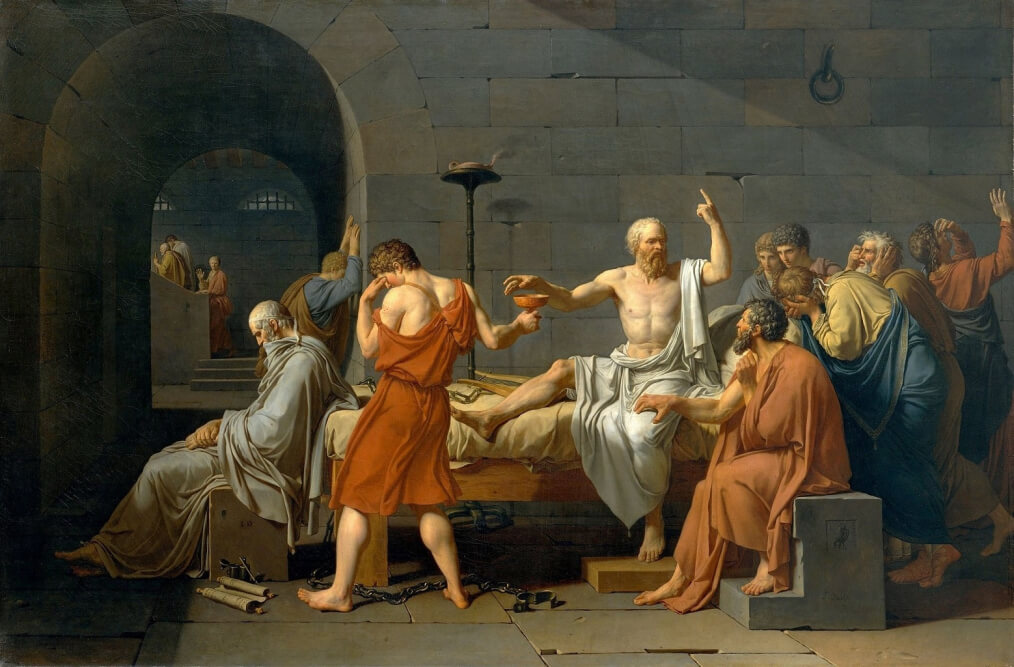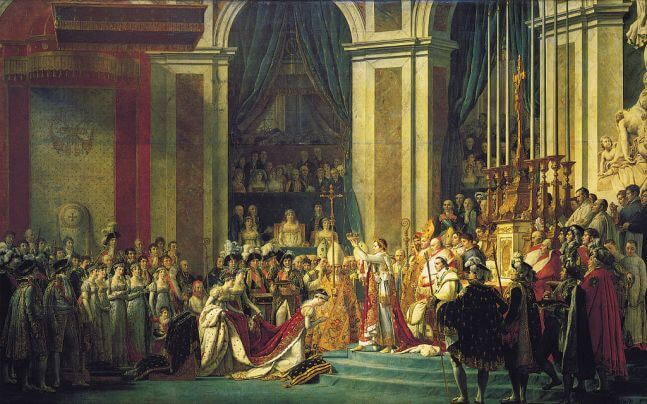 The wife of Socrates The wife of Socrates
Where? Room 621 of the Metropolitan Museum of Art
When? 1787 Commissioned by? The Trudaine de Montigny brothers What do you see? Socrates is sitting on his deathbed in his cell and is reaching for the glass of hemlock to take his own life. He is convicted to death by a jury in Athens for not believing in the Greek gods and for sharing this view with the young people in Athens. You can see the opened shackles laying on the floor. His disciples are gathered around him and cannot believe what is going to happen. The executioner from the state is holding the glass for Socrates while looking away and covering his eyes. Even in the moment just before his death, the illuminated Socrates is teaching to the people around him with his hand up in the air. Plato is sitting at the end of the bed with his back towards Socrates and his eyes closed. He seems in his thoughts, but his ear is prominently depicted to indicate that he is listening to Socrates. Plato has documented several dialogues of Socrates as Socrates himself did not leave any written documents. You can see the scroll and the pot with ink at Plato’s feet to indicate that he will document the final speech of Socrates. Sitting to the right of Socrates is Crito, a good friend of Socrates, who has his arm on his leg. Crito is sitting on a bench with an inscription of the symbol of the Athenian state. The wife of Socrates, Xanthippe, is in the left background in a red robe. She waves at us while walking away. Backstory: This painting is largely based on a dialogue of Plato, entitled Phaedo, in which he describes the death of Socrates. In this dialogue, Socrates discusses the life after death on the day before his execution. Socrates discusses various arguments on why the soul is immortal and that there is an afterlife for the soul. For his crimes, Socrates could choose between drinking the glass of the poisonous hemlock or being exiled. Given his ideas that his soul would go to an afterlife and staying true to his beliefs, he chose to drink the glass of hemlock. This painting can be interpreted in a political context. The Trudaine de Montigny brothers (who commissioned this work) were leaders of a movement that called for more open public discussion of political matters and a free market system. The motive behind this painting was to depict Socrates as an example of someone who was willing to die for his ideals. In 1787 reforms to the French political system were abandoned and there were many political prisoners. What is discussed in Phaedo? Phaedo is the fourth and final dialogue of Plato about the death of Socrates. In Phaedo, the story of Socrates is told about why he thinks that the soul is immortal and that there is life for the soul after a person dies. Phaedo also describes the death of Socrates. In short, the four arguments of Socrates are:
Who is Socrates? Socrates is one of the founders of Western philosophy. He was married to Xanthippe and got three sons. Socrates did not write any of his ideas on paper, but some contemporaries, such as Plato, have documented the ideas of Socrates such that his ideas have been saved for future generations. One of his most important contributions to the world is the so-called Socratic method. To solve a problem, Socrates would ask you a question. Based on your answer he would ask you another question, followed by another question, etc. He forced people to critically think about their answers by engaging them in the topic. If some of those answers led to contradicting answers, a certain hypothesis about the problem could be eliminated, and a better one could be formulated. It is basically a test of logic and will help a group of people to determine their views on a certain problem. The Socratic method has led to the currently-used scientific method that academicians use in which one starts with a hypothesis which can be rejected or accepted after research. Who is Jacques-Louis David? Jacques-Louis David (1748-1825) was born in Paris. He was a Neoclassical painter and together with Antonio Canova he is one of the main representatives of this art style. In his twenties and thirties, he spent quite some years in Rome where he got inspired by the Renaissance paintings and especially by the work of Raphael. David supported the French Revolution and Napoleon, and one of his famous paintings is The Coronation of Napoleon which is in the Louvre. After the fall of Napoleon, he moved to Brussels where he stayed until his death. He loved to make historical paintings while staying true to his Neoclassical style. In this painting, you can, for example, see how the body of Socrates resembles an ancient Greek sculpture. One of his most famous students is Eugene Delacroix.
Fun fact: There are several aspects of this painting that Jacques-Louis David changed compared to the historical accounts of the death of Socrates.
Written by Eelco Kappe
References:
2 Comments
qwertyuiop
11/5/2017 01:49:33 am
"Plato is sitting on his deathbed in his cell and is reaching for the glass of hemlock to take his own life." Shouldn't it be Socrates?
Reply
Tripimprover
11/5/2017 07:33:05 am
You are correct, thank you! I have updated this information.
Reply
Leave a Reply. |
Categories
All
|
- Home
- Blog
-
Museums
- Alte Pinakothek
- Art Institute of Chicago
- Baltimore Museum of Art
- Barber Institute of Fine Arts
- Bargello
- Barnes Foundation
- British Museum
- Church of Sant’Anastasia
- Cleveland Museum of Art
- Courtauld Institute of Art
- Detroit Institute of Arts
- Frans Hals Museum
- Galleria Borghese
- Gallerie dell'Accademia
- Getty Museum
- Guggenheim
- Hermitage Museum
- Kunsthistorisches Museum
- Kunstmuseum Basel
- Legion of Honor Museum
- Louvre
- Mauritshuis
- Metropolitan Museum of Art
- Musee d’Orsay
- Museum of Fine Arts in Boston
- Museum of Modern Art
- National Gallery in London
- National Gallery of Art
- National Museum in Poznań
- Norton Simon Museum
- Ny Carlsberg Glyptotek
- Palace of Versailles
- Palazzo Pitti
- Palazzo Vecchio
- Petit Palais
- Philadelphia Museum of Art
- Prado
- Pushkin Museum
- Ravenna Art Museum
- Rijksmuseum
- San Diego Museum of Art
- Santa Maria delle Grazie
- St. Peter's Basilica
- Städel Museum
- Statens Museum for Kunst
- Tate Britain
- Tate Modern
- Timken Museum of Art
- Uffizi
- Vatican Museums
- Wallace Collection
-
Artists
- Altdorfer
- Anguissola
- Berlin Painter
- Bosch
- Botticelli
- Boucher
- Bronzino
- Bruegel the Elder
- Brunelleschi
- Cabanel
- Caillebotte
- Canova
- Caravaggio
- Carpeaux
- Cezanne
- Cimabue
- David
- Degas
- Delacroix
- De Maria
- Donatello
- El Greco
- Fontana
- Fra Angelico
- Fragonard
- Gauguin
- Gentileschi
- Gericault
- Gonzalez-Torres
- Goya
- Hals
- Hogarth
- Hokusai
- Ingres
- Leonardo da Vinci
- Lippi, Filippo
- Longhi, Barbara
- Lorrain
- Makovsky
- Manet
- Massys
- Matisse
- Merian
- Michelangelo
- Mochi
- Modigliani
- Monet
- Panini
- Parmigianino
- Perugino
- Picasso
- Pisanello
- Raphael
- Rembrandt
- Renoir
- Reynolds
- Rivera
- Rodin
- Rubens
- Scultori
- Seurat
- Steen
- Tintoretto
- Titian
- Toulouse-Lautrec
- Turner
- Uccello
- Van der Weyden
- Van Dyck
- Van Eyck
- Van Gogh
- Van Hemessen
- Vasari
- Velazquez
- Vermeer
- Veronese
- Vigée Le Brun
-
Locations
- Books
- About Us


